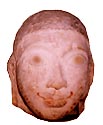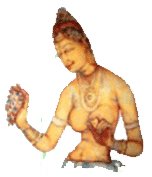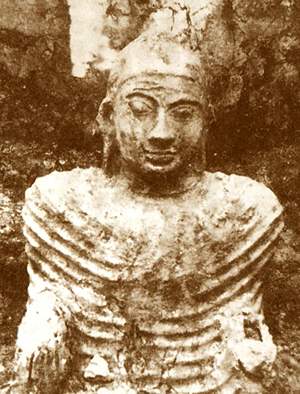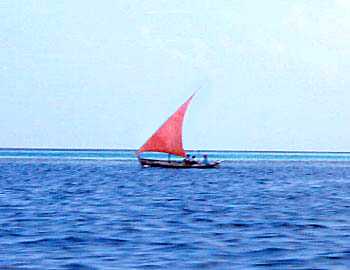|
Koimala
Kalou (Lord Koimala) was the first king of the Homa (Lunar)
Dynasty, which some historians call Theemuge.
 This
legendary nobleman of the Lion Race from Ceylon, sailed to Rasgetheemu
island (literally King's Town) in North Maalhosmadulu Atoll
and from there to Malé and established a kingdom there.
By then, the Aadeetta (Sun) Dynasty had for sometime
ceased to rule in Malé, possibly due to invasions by
the Cholas of Southern India in the Tenth Century. The indigenous
people in Malé Atoll, the Giraavaru
invited Koimala to Malé and permitted him to be proclaimed
king. Koimala Kalou (Lord Koimala) reigned as King Maanaabarana
and was succeeded by his nephew Dhovemi. Koimala was a Buddhist. This
legendary nobleman of the Lion Race from Ceylon, sailed to Rasgetheemu
island (literally King's Town) in North Maalhosmadulu Atoll
and from there to Malé and established a kingdom there.
By then, the Aadeetta (Sun) Dynasty had for sometime
ceased to rule in Malé, possibly due to invasions by
the Cholas of Southern India in the Tenth Century. The indigenous
people in Malé Atoll, the Giraavaru
invited Koimala to Malé and permitted him to be proclaimed
king. Koimala Kalou (Lord Koimala) reigned as King Maanaabarana
and was succeeded by his nephew Dhovemi. Koimala was a Buddhist.
Since
Koimala's reign, the Maldive throne was also known as the Singaasana
(Lion Throne). Before then and in some situations since, it
was also known as the Saridhaaleys (Ivory Throne).
There was a Maldives before the saint of Tabriz
Who in history was lavishly praised.
There was a Maldives before the time of any kateeb
Off the coast of Serendeeb.
|
Several
foreign travellers, mainly Arabs, had written about a kingdom
over the Maldives ruled by a queen. This kingdom pre-dated Koimala's
reign. Idrisi (1099 - 1186) referring to the writings of earlier
writers mentions the name of one of the queens. Her name was
Damahaar. She was a member of the Aadeetta (Sun) dynasty. The
Homa (Lunar) dynasty soveriegns inter-married with the Aaditta
(Sun) Dynasty. This was why the formal titles of Maldive kings
until 1968 contained references to "kula sudha ira"
which meant "descended from the Moon and the Sun".
No
official records exist of the Aadeetta Dynasty reigns.
|
The
following is a translation of the legend of Koimala Kalou as narrated
by Buraara Koi
In very ancient
times there was a king who ruled in Serendib (now Sri Lanka). Whenever
the cattle herds of the townsfolk became small the king would send
able bodied men into the jungle to muster wild cattle. The men whipped
the wild herds into submission and drove them close to the city.
At that time
there lived a very poor couple outside the city of the king of Serendib.
After enduring a long time in poverty the poor woman's husband died.
At the time of his death, the woman was three months pregnant. About
six months later the woman gave birth to a baby boy. When the boy
was just a toddler, his mother died too. Having lost his mother and
father, the little boy crawled out into the jungle and found himself
in the midst a huge herd of cattle. The boy was adopted by a suckling
cow and he began running around on all fours like the little calves
in the herd.
One day the
cows and bulls suddenly raised the alarm and the calves were driven
in front of the herd. The little boy was with the calves. A very loud
noise was heard and a huge serpent crawled out of the jungle into
a clearing and disappeared into a cave in the woods on the other side.
The little boy marked where this cave was.
Meanwhile in
the city the king of Serendib again ordered his men to go out into
the jungle to round up cattle. These people saw the boy living with
the cattle. They returned to the city and with the king's command
captured the boy and brought him back to the city. After a year of
treatment by physicians the boy was able to walk upright. The king
then ordered the boy to be taught the language of human beings. After
he was able to speak he was brought before the king.
The king asked
the boy if he had parents and the boy replied, "Sir, you brought
me here when I was living with my parents". The king then asked
him of the most extra-ordinary wonder he had seen in the jungle. The
boy then related the story of the huge serpent he saw when he was
living with the cattle. Having heard this the king remarked that the
the boy was like a flower in the jungle. This was why people started
calling the boy Koimala, which meant "Flower Lad".
The king of
Serendib comanded Koimala to show him the cave he saw in the jungle.
Koimala led the king and a huge retinue of people to the cave. There
was no one among the king's men who dared enter the cave because they
had heard that Koimala had seen a huge serpent enter it. Koimala then
suggested that a fire be lit at the entrance of the cave in order
to smoke the serpent out. The serpent did not emerge and no one was
willing to enter the cave. Koimala then entered it and returned to
tell the king that the bottom of the cave was full of sand. Koimala
brought back a sample of what he called sand. The king and his men
were dumbfounded with what they saw because what Koimala called sand
was all manner of gems. When the king's men saw this there was no
one left who did not volunteer to go down the cave.

Maldive image of the Buddha in a buried temple excavated on Thoddu
island in Ari Atoll. Such finds of pre-Islamic relics are systematically
vandalised and destroyed. Ordinary people are not encouraged to
find out that Maldivians could ever worship a deity other than
Allah. Among the artifacts excavated from the same temple included
a Roman
republican coin that went out of circulation circa AD 100. |
The king ordered
the treasure to be carried back to the city. This work went on for
days and eventually had to be stopped because there was no more storage
left to store the treasure.
The king then
summoned the learned men and the nobles of the city and asked them
if the treasure from the cave belonged to him. They replied that the
treasure belonged to Koimala, the Flower Lad of the Forest. The king
then asked the nobles and wise men how this treasure could become
the property of the king. They replied that if there was no one to
inherit it then it would become the property of the state and some
of them suggested that Koimala be put to death. Others suggested that
if the king's daughter were given to Koimala in marriage then the
property would pass on to the king.
| Feedback |
|
From:
"arm" <arm2000@hotmail.com>
To: <majid@maldivesroyalfamily.com>
Sent: Sunday, 6 October 2002 05:01
Subject: When you were offline...(via Bravenet HumanClick)
i'm bit shocked by the expression: "Such finds of pre-Islamic
relics are systematically vandalised and destroyed, because
ordinary people are not encouraged to find out that Maldivians
could ever worship a deity other than Allah." when u have written
so im left to assume u knew it all and there is no possibilty
of any another reason other than that! could not there another
reason for that which u are not aware of? do ask urself. i wish
u would try to be unbiased n try to be more optimistic towards
ur own ppl. will i be correct to assume that u sort of don't
like islam n arabic culture?
don't
be mistaken as u did b4. im not in the maldives n working for
the govt, but i just wanted to let u know where i disagree with
u. i've read a lot from ur pages n found most of them to be
tremendously interesting but now ive sort of lost the credibilty
n reliabity in them.
|
| Majid
replies |
|
Hello
again "Arm"
I
am glad to see that you are keeping up-to-date with what I write
in my site. You refer to my statement on the systematic destruction
of pre-Islamic relics in the Maldives. Several other writers
concur with what I have written. Even a cursory skim through
what authors such as Thor Heyerdahl have written would confirm
the attitude. If you know of any other reason for such vandalism
you are welcome to tell me what it is instead of asking me a
rhetorical question. You have told me, "try to be unbiased n
try to be more optimistic towards ur own ppl". I sincerely feel
I have treated my own people with dignity and the respect they
deserve. Most of what is in my site is about my people, the
Houses of Hilaaly and Huraagey on my father's side and the House
of Diyamigily on my mother's side. What I have written about
my people such as both my grandfathers and my wife's grandfather
(who was my father's first cousin) is complimentary as much
as it is factual. Writing about eight centuries of one's own
family could hardly be described as being biased AGAINST one's
own people.
At
least I have the courage of my conviction to write under my
own name. I make no secret of who I am. On the other hand, it
would seem that you are writing to me under a pseudonym or a
nickname. I have never assumed that you are working for a government
and I have not suggested that you are writing on behalf of a
government. There are electronic means of ascertaining that
you are not writing from the Maldives and I know that you are
not. The fact that you are writing from outside the Maldives
tells me nothing about your affiliation, if any.
So
"Arm", instead of telling me who you are not, it may be worth
telling me who you are and properly introduce yourself.
|
In
a subsequent mail, the individual identified himself as
"A. R. Mubarique". The email he wrote passed
through several identifiable computers before it reached
me.
Enquiries
by the Maldives Royal Family website indicate that the
individual is an activist in the Maldive Students' Association
(MSA) in Britain, which is a body set up with the active
backing of the Maldive regime
The
name "Abdul Rahman Mubarique featured in the website
of the MSA as a "Volunteer Selected for Website Improvement"
on 3 March 2002.
Mr
Mubaarique has asked that his feedback be removed from
this page saying that he "hates fame". He calls
his feedback "negative".
He
is "not interested in politics which is all about
empty promises" and is of the opinion that his feedback
is being linked to the Maldive regime.
The
following is a quote from the website of the London (England)
based organisation of which he is an active member.
"Number
9 Rosemont Avenue is a three bed room house in north London
that Maldivian students can use under certain conditions
courtesy of the Government of Maldives.............This
house is currently managed by the Maldivian High Commission
and the MSA(UK)."
|
|
The king's
daughter was then married to Koimala, but Koimala was not allowed
to meet his new bride. She was kept in a palace far away from an estate
where Koimala was made to live. The king sent for the wisemen and
nobles again for a ruling on the ownership of the treasure. They advised
him that the nature of the domestic arrangement of Koimala and his
new bride meant that the king was still not legally the owner of the
treasure.
The king then
brought Koimala and asked him how the king could claim ownership of
the treasures. Koimala suggested that two huge ships be built and
loaded with treasures and manned with a crew of slaves. If the king
permitted his daughter to sail from the country, the remainder of
the treasure would be his, Koimala suggested.
The king of
Serendib agreed with Koimala's terms and let his daughter and Koimala
sail into exile.
They sighted
two tiny islands and came ashore on one of them. Koimala and his entourage
put up tents and settled down on that island. Koimala ordered his
slaves to settle on the other island. The Flower Lad of the Forest
Koimala then named his island Rasgetheem which meant King's Town and
the other island Alhugetheem, which meant Slave Town. Alhugetheem
is now pronounced Agolhitheem.
When Koimala
settled on Rasgetheem there were still a few indigenous people on
the neighbouring islands. Koimala invited them all to Rasgetheem for
a feast and killed them. After that Koimala became the Lord of these
islands.
Lord Koimala
put the slaves from Agolhitheem to work on building a bath on his
island. While the lord watched the men dig the bath, he saw seven
birds fly towards Rasgetheem. The birds called out as they came overhead
and turned back and flew off in the direction from which they came.
Koimala ordered the slaves to stop work immediately and return to
Agolhitheem.
A long time
later the slaves were brought back to dig the same bath. As they dug,
five birds came overhead like the last time, called out and flew off
to were they came.
As before the
slaves were ordered to stop work and return. Several days later they
were brought back again to dig the bath. This time it was just one
bird that came and flew off only to return a second time to call out
and fly away in the direction it came.
Koimala ordered
the slaves to launch the lifeboat of the main ship. When the boat
was ready, Koimala, his wife, the nobles and slaves sailed in the
lifeboat and travelled in the direction the bird flew. The bird led
the way ahead and the lifeboat followed. Several days and nights later
the bird landed on an island in Malé Atoll which was promptly
named Doonidu, which meant Bird Island.
As the boat
moored off Doonidu the bird flew off and landed on a desert island
called Malé. Koimala ordered his crew to sail to Malé
where they found a group of rough fisherman in makeshift huts. These
fishermen spoke the language of the Fureytha demons.
Koimala asked
the fishermen for permission to settle in Malé and they said
that Malé was not worth living on. They also said that there
were other islands that were better suited for living. Koimala was
not interested in settling on any other island and the amused fishermen
willingly consented for this group of odd foreigners to settle on
their desert island.
There
was a Maldives that was known for the demons of old
In ancient South Indian folklore.
But there was one thing strange with those times
And thatís how they lived with no judges, jails or crimes!
|
 Koimala
then sent the slaves back to Rasgetheem to bring the two ships to
Malé. A missive was then sent to Koimala's father-in-law the
king of Serendib asking him to send the material and people necessary
to establish a new kingdom. The king of Serendib sent a group of people
of the Lion race who wore very little clothing only around their loins. Koimala
then sent the slaves back to Rasgetheem to bring the two ships to
Malé. A missive was then sent to Koimala's father-in-law the
king of Serendib asking him to send the material and people necessary
to establish a new kingdom. The king of Serendib sent a group of people
of the Lion race who wore very little clothing only around their loins.
Koimala worshipped
idols as did the people of Serendib. Soon many buildings were constructed
in Malé including two colossal idol temples. The entrance to
the town of Malé was flanked by two towering idols.
When the new
capital was built, Koimala
was proclaimed king over all of the Maldives.
There was a Maldives with sea shells and ocean breeze
Before the creed of the Buddha was preached.
Buddhan Saranan Gaddaami
Dharuman Saranan Gaddaami
Sangan Saranan Gaddaami
- ancient Divehi creed of the Buddha
|

|

